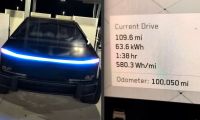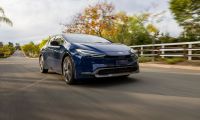The 2016 Chevrolet Volt is expected to be a great improvement over its predecessor, the controversial yet highly praised pioneer that helped usher in the current era of electric vehicles. Along with the recently introduced BMW i3, it remains the only plug-in hybrid (the Volt and i3 REx are actually range-extended electric vehicles) to achieve very meaningful all-electric range.
From an engineering perspective, the Volt is an unprecedented success and a technological marvel. In fact, GM has called the Volt the most highly engineered car it has ever built.
Its clever powertrain allows 40 miles of all-electric driving yet enables long trips on electric power via a gasoline range extender – the Voltec drive unit is so complex it requires its own article. The unique powertrain has had few real problems to date, yet GM saw fit to completely redesign the system to make it lighter, faster, and more efficient.
At an exclusive event at the Los Angeles Auto Show last week, GM allowed a select group of current Volt owners to glimpse the new model after signing a non-disclosure agreement. The general consensus was that the car looks good – the question everyone else was asking, though, was whether the lucky guests got a view of the fifth seat or lack thereof.
One of the biggest shortcomings of the current Volt is seating for four, which limits its appeal. GM listened closely to feedback from Volt owners in its development process of the next-generation car, so it was expected that they would heed the calls for a fifth seat.
Inside EVs reported late last week that some of those sneak peekers violated their non-disclosure agreements, revealing that they did indeed see a rather cramped and uncomfortable-looking fifth seat where previously there was only an armrest. This is likely designed for children or the rare designated-driver trip, as GM smartly seems to have added a fifth seat to appease the crowd without compromising the other aspects of the vehicle. Even if it was a well-engineered fifth seat, the car is only so wide - how often are five adults going to pile in a compact sedan anyway?
A self-fulfilling prophecy from General Motors?
In August, electric vehicle advocates may have been dismayed to learn that GM plans to tone down expectations for the 2016 Chevrolet Volt. After being heavily criticized for overestimating sales volumes of the original Volt, GM seemed to have learned its lesson: Volt chief marketing officer Tim Mahoney stated that the range-extended EV is “not a mass-market vehicle.”
Citing stronger demand in obvious electric vehicle markets, Mahoney claimed that “there’s a Northeast and West Coast market for the Volt, and there’s nothing wrong with that.”
However, especially given the improvements GM has made from the original Volt to the second generation, which will debut in January at the North American International Auto Show, there seem to be few reasons why the Volt should not target the mass market.
Unlike battery electric vehicles that are inherently range-limited and therefore largely restricted to urban markets, especially areas with robust public charging infrastructure, the Volt can go anywhere and performs quite well doing it. It does not have to be a second car, parked alongside an ICE vehicle dedicated for road trips. And the vast majority of Americans drive fewer than its 40 miles of electric range per day.
The Volt has also had unprecedented success drawing new buyers, called “conquests,” to the Chevrolet brand – in many cases customers that would otherwise have never considered a Chevy. It has also achieved some of the highest owner satisfaction scores of any car on the road.
What stands in the way
With the seating-for-five excuse out of the way, there remain two prominent obstacles between the Volt and the mass market: price and dealerships.
The current Volt starts at $34,170, and many are hoping that the price drops significantly with the next-generation model. Despite a larger battery, we believe it is safe to expect a modest price decrease due to upgraded battery technology and other cost reduction measures. Would an MSRP of, say, $32,000 be enough of a price drop to capture more mainstream consumers, especially given the prodigious gasoline savings of current Volt owners? The pricing of the 2016 model is eagerly awaited.
That other obstacle is more related to GM’s willingness to market and distribute the Volt. Though many dealers stock plenty of Volts and are eager to move them, particularly in EV-friendly markets, it is not a stretch to say that too many Chevrolet dealers across the country either do not stock the Volt or are quick to steer customers toward a conventional vehicle instead.
If GM were to provide better education and training of its dealerships (and more inventory) in conjunction with a legitimate, revamped nationwide marketing plan for the Volt, we believe it could sell in much greater numbers than it has for the past few years. At least initially, however, it appears that GM will rely on a regional marketing strategy while leveraging existing Volt owners as evangelists.
Though this scheme as well as the great improvements to the next-gen model will certainly help boost sales, the Volt will remain a niche vehicle as long as GM is convinced that it cannot reach the mass market.













Comments
This was an excellently
Permalink
This was an excellently researched and well written article. Missing from it was mention of the $7,500 Federal EV tax credit, of which GM has approx 120,000 out of 200,000 credits remaining. And polling shows that many of not most consumers even a few years in are still unaware this credit even exists. If Volt 2 can manage to pull off 50k+ sales a year the first two years (even if just in the two primary CA and NE US markets), it would be a huge success and we can hope GM will do another price drop below $30k after 2017 to compensate for the possible expiration of the tax credits.
They really don't have much
Permalink
They really don't have much choice when it comes to marketing. In the past, for every dollar GM spent marketing the Volt, "special interest lobby groups" spend twice that making up FUD against it.
The most glaring example of this is the NLPC, a for hire attack group that spent major $$$ on google ad word campaigns and Fox new promo spots promoting Hoax articles against the volt. This included the fake fire stories as well as the idea that the only people buying it are government fleet operators.
GM needs to follow thru with the same advertising approach as TESLA, avoid throwing money away competing for ad space in print and online sites awash in feel good oil company ads and let the early adopters and grass roots do the talking.
The deals are another problem. Most make their profit from service and parts, both of which the volt dosnt need very much of, so it just no profitable for them to promote the car.
GM needs to streamline its dealership network and remove those who do no wish to sell its products.
I gotta agree with Mark,
Permalink
I gotta agree with Mark, Ottaway nailed it with this article. I have followed the Volt since late in 2007 and rarely do authors understand the Volt. I am hoping the base Volt MSRP will come in at $29,990 but $32k is probably closer to where the number will be.
The main question we won't see answered until after the 2016MY Volt is released is, will GM market the car or will they let it wither on the vine. The speculation is that they were losing a little money on the base Volts to start with in 2010/2011 and only recently got to the point where the economies of scale decreased the price to produce each Volt to the point where they were making a small profit on them. But the entire thrust of the Gen II Volt development seems to have been on pushing two points forward, making the Volt incrementally better while making it less expensive to produce. It sounds like GM has succeeded on both counts, but if we see little to no marketing in the next 12 months, we will know that they fell short on making the Volt profitable.
Great article. My bet is
Permalink
Great article. My bet is that GM will offer two battery options to get the Volt down to below $30k. Perhaps a 30 mile range for $29k and a 45-50 mile option for $35+ . My commute is 25 miles round trip so I'm happy with a 30 mile range to save some money on the upfront cost of the car.
Yes good article Luke. Was
Permalink
Yes good article Luke. Was thinking a 6.6 kw charger as an option would be nice given the larger battery. The 5th seat was/is not a deal breaker for me but would help with resale value. Really like the improved fuel economy, regular gas and better AER. Always good to see lower prices if quality is not impacted.
We have leased a Volt for 3
Permalink
We have leased a Volt for 3 years and can't wait to get the 2016 hopefully in March!
Followed this car before
Permalink
Followed this car before initial intro and was very enthusiastic. Then it came out, looked sharp, well built, but too small. I can live with 4 seats but it needs about 2" more wheelbase and 1" more headroom for me to be comfortable and carry back seat passenger at all. Hope GM listens to more than just owners who will be a self selected group that fit in the car as is. My non Prius hybrid lease is up next summer and I would love to replace it with a volt if it fits! 32k price would be fine.